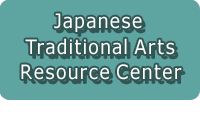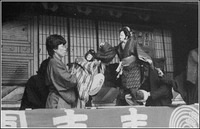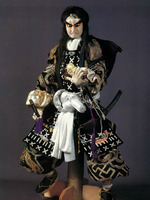

Total:35items

 |
|
 《Feature》
《Feature》Despite the unknown beginning of its history, Awa (current Tokushima Pref., West Japan) Ningyo Joruri, or Awa Puppet Theater is well known to originate from then-prosperous Awaji (current Hyogo Pref., West Japan) Puppet Theater mastered by farmers in Awa region around the 16-17th century. The performing art further developed in Awa under the patronage of Hachisuka family, the feudal lords of Tokushima domain. The lords ordered the Uemura Gennojo or Ichimura Rokunojo troupe to perform puppet shows at every auspicious occasion during their governance. Historical records show the long-term relationship between the Hachisuka family and Gennojo troupe. For example, the first lord gave the third-generation Gennojo a pardon for tax payment by labor of 15 people. Another example is that the seventh-generation Gennojo was ordered to perform puppet shows in the castle while his performance outside the domain had been suspended for seven years.
Records describe that the middle Edo period, around the 18th century, saw some 40 Awaji Puppet Theater troupes, while unfortunately no records of Awa Puppet Theater troupes during the domain's administration survive today. However, the 10 currently-remaining puppets reportedly made by Komazo, a puppeteer in the early 18th century, allow us to infer the existence of the equivalent number of troupes in Awa to that of Awaji. Historical literature "Motoki Ancient Document" from 1808 to 1855 presents the records of the Awa Puppet Theater in detail about the troupes' performance across the prefecture, then-popular puppet dramas, and successes and failures in their performance influenced by the social business conditions at that time. According to the records, professional Awaji puppet theater troupes were on tour from village to village throughout a year, sometimes with child puppet theaters, temporary playhouses, and performance in the precincts of temples. The shows were generally performed for 16 days, while one of the longest was reportedly lasted for 25 days at Inari-za Theater in Tokushima Prefecture. During a day, a troupe typically performed continuously for seven hours from 9:00 a.m. to 5:00 p.m. There were also some exceptional dramas such as "Chushin-gura" ("Revenge of the Forty-Seven Ronin") which took 9 hours to complete. According to "Tenguya Hisakichi Geidan" ("Tenguya Hisakichi's Talks on the Arts") by Soshichi Kume, the only historical document regarding Awa Puppet Theater troupes is the order books of the local master puppet craftsman named Tenguya Hisakichi around the end of 19th century, which recorded 74 troupes, their addresses and names of the heads. Presumably, Awa Puppet Theater reached its peak in this period. The master left several impressive phrases about the Theater: "The Awa Puppet Theater troupes mostly consisted of amateurs without performing an entire drama. Some troupes in Ikeda, Hiruma, or Kamo presented performance joined by professionals from Awaji at times"; "I hear that most Tayu, or joruri narrators are from Awa, few from Awaji since long time ago, while most shamisen players are seemingly from Awaji."
Puppet Theater was led on the wane due to the emergence of new types of entertainment in the middle Taisho period (1910s-20s), such as kinemas, magic lanterns, and peep shows in, and in the early Showa period (1920s-30s) such as films, comic dialogues, and comic storytelling. Furthermore, WWII forced many troupes to dissolve. However, when the war ended, Awa Ningyo Joruri Promotion Association was established and joruri narrators, shamisen players, puppet theater troupes, and puppeteers all gathered to revive the traditional "Awa Ningyo Joruri". As many as 10 troupes already existed at that time. Fortunately, in 1949, Naruto Gennojo troupe in Naruto city was granted an opportunity to perform their drama in the presence of the empress or crown prince at former Akasaka Detached Palace. Subsequentlyin August 1930, Joruri Festival was held for 15 days. This festival is held every year since 1975 despite the temporary interruption, attracting many Joruri lovers as well as local people as a popular event. . Nowadays, many young successors have been developed and support Awa Ningyo Joruri.
【Awa master puppet craftsmen】
Awa has produced so many master puppet craftsmen that most puppet heads currently used in Ningyo Joruri are considered as their artworks. Commonly accepted, the first master is Komazo who was active in the Edo period (middle 18th century). Compared to Bunraku with high entertainment, puppet theaters of Awa and Awaji feature their more religious characteristics. Puppet Theater, which is usually performed at temporary playhouses in conjunction with festive rites of Shinto shrines and events of temples, often accompanies Hako-mawashi and Ebisu-mawashi, or portable puppet shows, at the gates of shrines and temples. These conditions influenced the manufacture of puppet heads. Before Tempo era (1830-1844) when Awa puppet making began to excel Awaji, Awa puppet craftsmen had used exactly the same model for Awa puppets as the Awaji puppets. In the early Meiji period (late 19th century), a bigger-headed model invented by Tengu Hisa gained popularity among puppet theater troupes traveling local areas and consequently became famous across the country. However, the changes brought by the new model including a heavier and bigger head as well as its six-head figure from the traditional 12-head figure gave grotesque-feel appearance to Awa puppets. Their particular appearance and also difficulty in expressing subtle feelings contributed to the rare use of Awa puppets by Bunraku puppet theaters.
【How to appreciate Deko dolls (puppets)】
The pivot of a Deko doll, or puppet, is its head, while other elements including their hands, legs, and costumes are all prepared according to their heads. Originally, puppet heads should be appreciated not in a standstill state but in movement in plays. In order to clearly represent the assigned roles and characters in plays, puppet heads often cannot help being presented in an exaggerated way or with extreme facial expressions.
[Nationally-designated important intangible folk culture asset]
Credit: Tokushima Prefectural Awa Jurobe Mansion
Translation: Tomoko Yamamoto, reviewed by Marina Izumi
| City/Town | Tokushima Prefecture |
|---|---|
| Location | 【Tokushima Prefectural Awa Jurobe Mansion】
The mansion has a stage and audience set inside, modelling a farm village stage formerly often seen in the precincts in shrines, andAwa Ningyo Joruri is performed every day. Besides many prepared materials of Deko puppets and puppet theater costumes, the facility offers you opportunities to learn various things such as how to move puppets and what roles are played by performers, Tayu (Joruri narrators) and shamisen players. |
| Contact | Tokushima Prefectural Awa Jurobe Mansion ("Awa Jurobe Yashiki")
Tel: +81-(0)88-665-2202 / Fax: +81-(0)88-665-3683 (Japanese only) Assistance needed? For inquiries in English: JTCO Contact Form Your inquiries will be forwarded by JTCO in Japanese to the organization you wish to contact. |
| Access | From JR Tokushima Sation …15 min by car, or near from bus stop "Jurobe-yashiki" after about 30 min by Kawauchi-junkan Bus (No. 7 Stop at Tokushima Municipal Bus Terminal
From Tokushima Expressway…5 minutes from Tokushima IC From Kobe-Awaji-Naruto Expressway…20 minutes from Naruto IC |
| URL | http://www.joruri.info/ |



